The
observations that certain fossils were associated with certain rock
strata
led early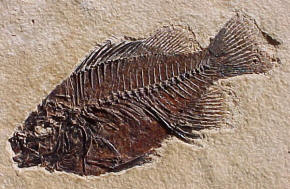 geologists to recognize a geological timescale in the 19th
century. The development of
radiometric dating
techniques in the early 20th century allowed geologists to determine the
numerical or "absolute" age of the various strata and thereby the included
fossils.
geologists to recognize a geological timescale in the 19th
century. The development of
radiometric dating
techniques in the early 20th century allowed geologists to determine the
numerical or "absolute" age of the various strata and thereby the included
fossils.
Like
extant organisms,
fossils vary in size from microscopic, such as single bacterial cells only
one micrometer in diameter, to gigantic, such as dinosaurs and trees many
meters long and weighing many tons. A fossil normally preserves only a
portion of the deceased organism, usually that portion that was partially
mineralized during
life, such as the bones and teeth of vertebrates, or the
chitinous
exoskeletons of
invertebrates. Preservation of soft tissues
is rare in the fossil record.
William
Smith (1769-1839), an English canal engineer, observed that rocks of
different ages (based on the
law of superposition)
preserved different assemblages of fossils, and that these assemblages
succeeded one another in a regular and determinable order. He observed that
rocks from distant locations could be correlated based on the fossils they
contained. He termed this the principle of faunal succession.
Smith, who preceded
Charles Darwin, was unaware of biological
evolution and did not know why faunal succession occurred. Biological
evolution explains why faunal succession exists: as different organisms
evolve, change and go extinct, they leave behind fossils. Faunal succession
was one of the chief pieces of evidence cited by Darwin that biological
evolution had occurred.
| NOTE: Not all old earth creationists accept evolution. About half of old earth creationists believe in progressie creationism. This belief states that God did not use evolution, but created each species as a unique creation which did not evolve from a prior species. If you have questions about the issue of theistic evolution vs. progressive creation, you should discuss these issues with your parents. |
Biological Explanations
Early naturalists well understood the similarities and differences of living species, leading Linnaeus to develop a hierarchical classification system still in use today. It was Darwin and his contemporaries who first linked the hierarchical structure of the great tree of life in living organisms with the then very sparse fossil record. Darwin eloquently described a process of descent with modification, or evolution, whereby organisms either adapt to natural and changing environmental pressures, or they perish.
When Charles Darwin wrote On the Origin of Species by Means of Natural Selection, or the Preservation of Favoured Races in the Struggle for Life, the oldest animal fossils were those from the Cambrian Period, now known to be about 540 million years old. The absence of older fossils worried Darwin about the implications for the validity of his theories, but he expressed hope that such fossils would be found, noting that: "only a small portion of the world is known with accuracy." Darwin also pondered the sudden appearance of many groups (i.e. phyla) in the oldest known Cambrian fossiliferous strata.
Since
Darwin's time, the fossil record has been pushed back to between 2.3 and 3.5
billion years before the present. Most of these Precambrian fossils are
microscopic bacteria or
microfossils. However,
macroscopic fossils are now known from the late
Proterozoic. The
Ediacaran biota (also called Vendian biota)
dating from 575 million years ago collectively constitutes a richly diverse
assembly of early multicellular
eukaryotes.
The fossil record and faunal succession form the basis of the science of
biostratigraphy or
determining the age of rocks based on the fossils they contain. For the
first 150 years of
geology,
biostratigraphy and superposition were the only means for determining the
relative age of rocks.
The
geologic time scale was
developed based on the relative ages of rock strata as determined by the
early paleontologists and
stratigraphers.
Since the early years of the twentieth century,
absolute dating methods, such as
radiometric dating
(including
potassium/argon,
argon/argon,
uranium series, and,
for very recent fossils,
carbon-14 dating) have
been used to verify the relative ages obtained by fossils and to provide
absolute ages for many fossils. Radiometric dating has shown that the
earliest known
stromatolites are over
3.4 billion years old. Various dating methods have been used and are used
today depending on local geology and context, and while there is some
variance in the results from these
dating methods, nearly all of them provide
evidence for a
very old Earth,
approximately 4.5 billion years.
Rarity of fossils
Fossilization is an exceptionally rare occurrence, because most components
of formerly-living things tend to decompose relatively quickly following
death. In order for an organism to be fossilized, the remains normally need
to be covered by sediment as soon as possible. However there are exceptions
to this, such as if an organism becomes frozen,
desiccated, or comes to rest in an
anoxic (oxygen-free)
environment. There are several different types of fossils and fossilization
processes.
Due to the combined effect of
taphonomic processes and simple mathematical
chance, fossilization tends to favor organisms with hard body parts, those
that were widespread, and those that existed for a long time before going
extinct. On the other hand, it is very unusual to find fossils of small,
soft bodied, geographically restricted and geologically ephemeral organisms,
because of their relative rarity and low likelihood of preservation.
Larger specimens (macrofossils)
are more often observed, dug up and displayed, although microscopic remains
(microfossils)
are actually far more common in the fossil record.
Some casual observers have
been perplexed by the rarity of
transitional species
within
the fossil record. The conventional explanation for this rarity was given
by
Darwin, who stated that
"the extreme imperfection of the geological record," combined with the short
duration and narrow geographical range of transitional species, made it
unlikely that many such fossils would be found. Simply put, the conditions
under which fossilization takes place are quite rare; and it is highly
unlikely that any given organism will leave behind a fossil. Eldredge and
Gould developed their theory of
punctuated equilibrium
in part to explain the pattern of stasis and sudden appearance in the fossil
record. Furthermore, in the strictest sense, nearly all fossils are
"transitional," due to the improbability that any given fossil represents
the absolute termination of an evolutionary path.
Young earth creationists are quick to point out the lack
of transitional fossils. In fact, numerous transitonal fossils
have been proposed, but young earth creationists consider these as
unique organisms unto themselves. Because of the basic belief
that no evolution occurred, young earth creationists reject all
claims of transitional fossils, no matter how strong the scientific
evidence.
Types of Preservation
Permineralization
Permineralization
occurs after burial, as the empty spaces within an organism (spaces
filled
with liquid or gas during life) become filled with mineral-rich groundwater
and the minerals precipitate from the groundwater, thus occupying the empty
spaces. This process can occur in very small spaces, such as within the
cell wall of a
plant cell. Small scale
permineralization can produce very detailed fossils. For permineralization
to occur, the organism must become covered by sediment soon after death or
soon after the initial decaying process. The degree to which the remains are
decayed when covered determines the later details of the fossil. Some
fossils consist only of skeletal remains or teeth; other fossils contain
traces of
skin,
feathers or even soft
tissues.
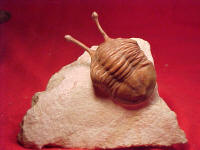
A permineralized trilobite
Casts
and molds
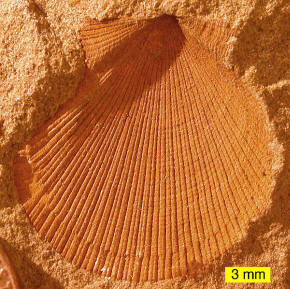
External mold of a bivalve from the Logan Formation, Lower
Carboniferous, Ohio.
In some cases the original remains of the organism have been completely dissolved or otherwise destroyed. When all that is left is an organism-shaped hole in the rock, it is called an external mold. If this hole is later filled with other minerals, it is a cast. An internal mold is formed when sediments or minerals fill the internal cavity of an organism, such as the inside of a bivalve or snail.
Replacement and recrystallization
Replacement occurs when the shell, bone or other tissue is replaced with another mineral. In some cases mineral replacement of the original shell occurs so gradually and at such fine scales that microstructural features are preserved despite the total loss of original material. A shell is said to be recrystallized when the original skeletal compounds are still present but in a different crystal form, as from aragonite to calcite.
Compression fossils
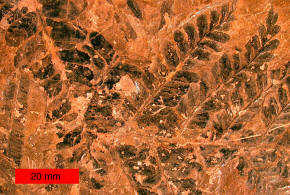
Example of a Compression Fossil. Fossil seed fern leaves
from the Late Carboniferous of northeastern Ohio.
Compression fossils, such as those of fossil ferns, are the result of chemical reduction of the complex organic molecules composing the organism's tissues. In this case the fossil consists of original material, albeit in a geochemically altered state. Often what remains is a carbonaceous film.
Bioimmuration
Bioimmuration is a type of preservation in which a skeletal organism overgrows or otherwise subsumes another organism, preserving the latter, or an impression of it, within the skeleton. Usually it is a sessile skeletal organism, such as a bryozoan or an oyster, which grows along a substrate, covering other sessile encrusters. Sometimes the bioimmured organism is soft-bodied and is then preserved in negative relief as a kind of external mold. There are also cases where an organism settles on top of a living skeletal organism which grows upwards, preserving the settler in its skeleton. Bioimmuration is known in the fossil record from the Ordovician to the Recent.
Microfossils
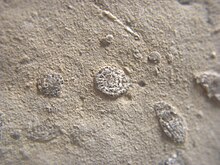
Microfossil is a descriptive term applied to fossilized plants and animals whose size is just at or below the level at which the fossil can be analyzed by the naked eye. A commonly applied cut-off point between "micro" and "macro" fossils is 1 mm, although this is only an approximate guide. Microfossils may either be complete (or near-complete) organisms in themselves (such as the marine plankters foraminifera and coccolithophores) or component parts (such as small teeth or spores) of larger animals or plants. Microfossils are of critical importance as a reservoir of paleoclimate information, and are also commonly used by biostratigraphers to assist in the correlation of rock units.
Resin fossils
Fossil resin (colloquially called amber) is a natural polymer found in many types of strata throughout the world, even the Arctic. The oldest fossil resin dates to the Triassic, though most dates to the Tertiary. The excretion of the resin by certain plants is thought to be an adaptation for protection from insects and to seal wounds caused by damage elements. Fossil resin often contains other fossils called inclusions that were captured by the sticky resin. These include bacteria, fungi, other plants, and animals. Animal inclusions are usually small invertebrates, predominantly arthropods such as insects and spiders, and only extremely rarely a vertebrate such as a small lizard. Preservation of inclusions can be exquisite, including small fragments of DNA.
Living
Fossils
Young earth creationists frequently point to "living fossils" as
proof of a young earth. However, a living fossil merely means
that a living organism is present in the fossil record. A
living fossil has nothing to do with the age of the earth.
Living fossil is an informal term used for any living species which is apparently identical or closely resembles a species previously known only from fossils—that is, it is as if the ancient fossil had "come to life."
This can be (a) a species or taxon known only from fossils until living representatives were discovered, such as the lobe-finned coelacanth, primitive monoplacophoran mollusk, and the Chinese maidenhair tree, or (b) a single living species with no close relatives, such as the New Caledonian Kagu, or the Sunbittern, or (c) a small group of closely-related species with no other close relatives, such as the oxygen-producing, primordial stromatolite, inarticulate lampshell Lingula, many-chambered pearly Nautilus, rootless whisk fern, armored horseshoe crab, and dinosaur-like tuatara that are the sole survivors of a once large and widespread group in the fossil record.
Index Fossils
Index fossils (also known as guide fossils, indicator fossils or zone fossils) are fossils used to define and identify geologic periods (or faunal stages). They work on the premise that, although different sediments may look different depending on the conditions under which they were laid down, they may include the remains of the same species of fossil. If the species concerned were short-lived (in geological terms, lasting a few hundred thousand years), then it is certain that the sediments in question were deposited within that narrow time period. The shorter the lifespan of a species, the more precisely different sediments can be correlated, and so rapidly evolving types of fossils are particularly valuable. The best index fossils are common, easy-to-identify at species level, and have a broad distribution—otherwise the likelihood of finding and recognizing one in the two sediments is minor.
Return to the Old Earth Ministries Online Earth History Curriculum homepage.
Source: Fossils
